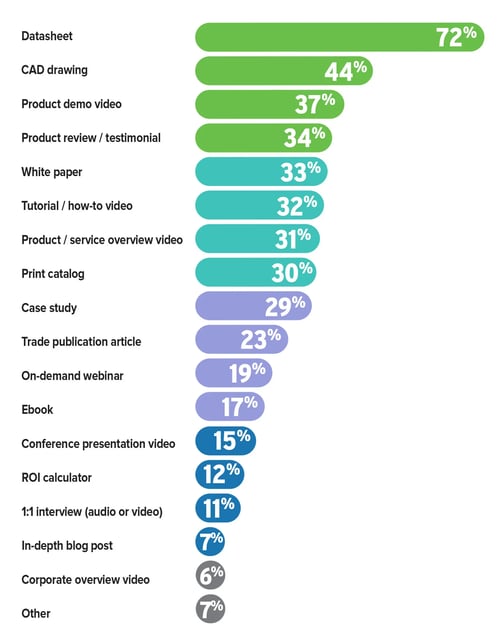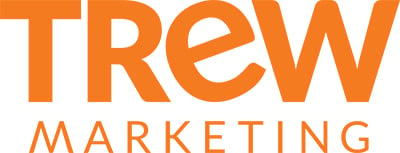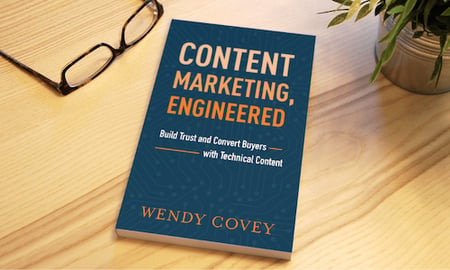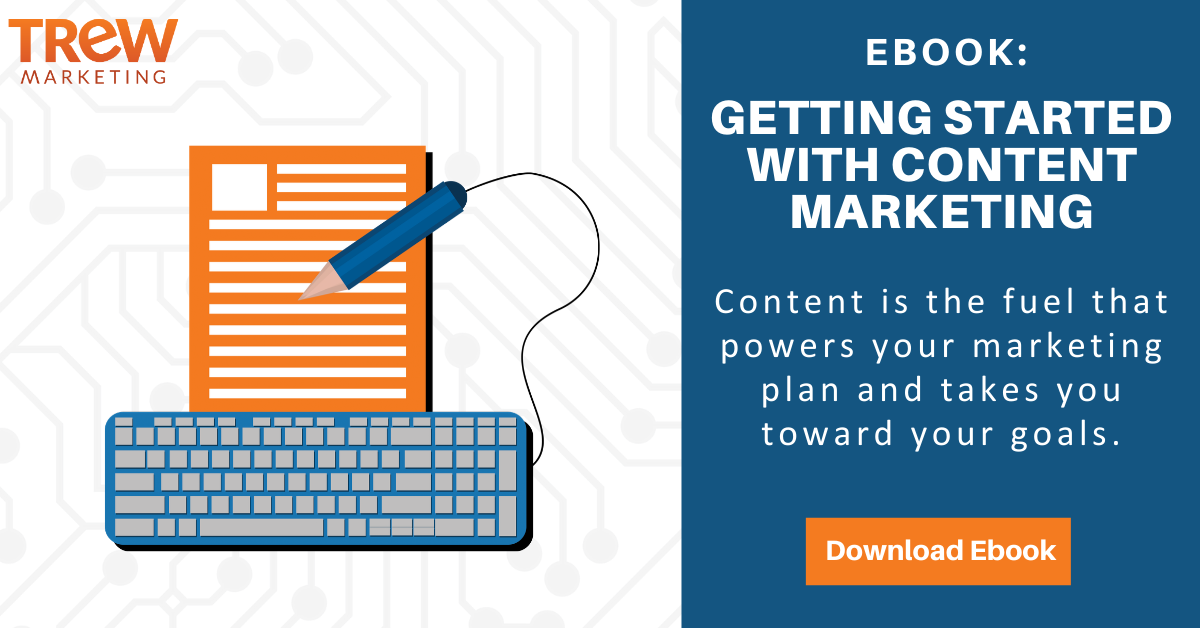6 min read
Content IS King: How to Write a Technical White Paper for Engineers
 Morgan Norris
:
3/14/23 10:28 AM
Morgan Norris
:
3/14/23 10:28 AM
For technical audiences, white papers have traditionally been seen as unbiased, lengthy academic articles that look like a chapter straight out of a textbook. However, nowadays many companies commonly use this media format in content marketing to attract new leads and inform potential customers.
Compelling content is vital to your marketing efforts – engineers need and expect technical content such as white papers, data sheets, and detailed customer testimonials.

These materials do much more than inform. Through engaging content, you increase trust, strengthen perceived value and brand loyalty, gain a higher click-through rate for content placed on your website, and ultimately generate new leads and sales.
For maximum impact, content must be:
- Current
- Engaging
- Educational
- Actionable
You have a variety of content avenues to choose from, so it’s important to begin with the most critical and prioritize quality vs. quantity, particularly when starting out. Assuming your website content is already developed, the next types of marketing content you should tackle include:
- Technical white papers
- Customer case studies
- Application-specific pillar pages
- Videos and interactive content
According to our State of Marketing to Engineers report, 83% of engineers are willing to fill out a form in exchange for technical content. The most useful types of content cited by engineers included a long list!
What form(s) of content do you find most valuable when researching to make a significant work-related purchase? Please select all that apply. (n = 699)

WHAT IS A Technical WHITE PAPER?
A technical white paper is text-based narrative that presents technical information in about 3,000 words or more. For use both online and in print, they generally contain images, diagrams, and even embedded videos and links.
In contrast with blog posts – which are usually shorter, are frequently written and address current trends and issues – white paper content tends to be lengthier and more in-depth.
Given the amount of time it takes to create a white paper, choose an “evergreen” topic that is not tied to a specific date or time period. Write the content in a way that addresses common or recurring pain points for your potential customers.
Common subject matters include:
- Introductory information about a technology
- How-to tutorials or best practices
- Authoritative reports about industry changes
- Lessons learned about an engineering challenge
- Analysis from your research and experience
The following steps can help you write a thoughtful and compelling technical white paper that will increase web traffic and gather highly qualified leads from potential customers.
How to Write a Technical White Paper
Establish the Purpose
Before undergoing the writing process for a white paper, it is essential to establish the purpose and parameters of the document. Marketing writers often have standard white paper questionnaires to fill out that lay out all the necessary information in the preparation stage.
Details to nail down may comprise of:
- Goals and Key Messages
What is this white paper for? What is the end goal you want the reader to do, understand, or believe? For example, G Systems build test systems for top aerospace and defense manufacturers. To promote their services, they wrote a white paper on 5 Aerospace and Defense Test System Design Mistakes to Avoid. By discussing important industry considerations interspersed with customer examples, this white paper shows how G Systems understands how to successfully design a test system for aerospace and defense.
Look at the big picture purpose of the white paper and determine what key messages about the company and its offerings the reader should come away with. - Audience
Who are the primary and secondary target audiences for this white paper? What is the reader’s level of knowledge about the subject matter? Make sure you are attracting the right kind of customer with your content marketing. - Tone
Decide whether to use a first-person versus third-person voice. With the first-person point of view, directly addressing the reader with “you” sounds more personal, whereas the third-person voice may sound more objective and unbiased. The level of objectivity may depend on the usage of the white paper, such as establishing credibility, attracting new clients, or sharing updates with existing customers. Regardless, use an authoritative tone that shows you are the experts on this topic. - Release Date and Timeline
Are there any deadlines for the release of the white paper? Will it be used for a product launch or the next company newsletter? Make sure you leave time in the schedule not only for writing, but also for reviews, copy editing, formatting, and printing or uploading onto the website. -
Length
If you have a lot of solid source material or if the discussion is fairly lengthy, will you shorten the white paper to make it more concise or will you create multiple white papers? If the subject matter is easily dividable, the content may have more widespread impact or greater longevity as an ebook with several chapters or as a series of articles released one at a time.
Begin the Writing Process
The key to writing a good white paper is to put yourself in the reader’s shoes and consider, “What does the customer want to learn?” However, the hook is just the first step to get the audience to start reading the article. Remember that ultimately your goal is not necessarily to keep the reader reading, but to get the reader to accomplish your goal and complete that next call-to-action (CTA).
Committing 3,000 or more words to paper may seem overwhelming, so the best way to defeat writer’s block is to create an outline. Does the structure and flow of the document make sense and drive to your key points and goals? Once the framework of the white paper has been established, take your source material and organize it under each outline point, adding extra notes and thoughts as they come to mind. Voilà! The first very rough “draft” has been completed.
- Outline Your Content
To make sure you provide adequate detail for your white paper, outline your content first, including the following recommended sections:
- Introduction – briefly define the topic of the white paper
- Challenge – describe the reader’s pain points
- Overview – tell what you will discuss in the paper and define key terms you will use
- Body – discuss the industry issue, technology, or product feature, including your solution or resolution to the challenge and related benefits; include quantifiable results that are expected, if applicable
- Call-to-action – what you want your reader to do next; examples include watching a video, visiting specific areas of your website, or requesting a product demo
- Use Images
Since white papers can be very text-heavy, keep the readers interest by breaking up the content with quotes, call-out text blocks, and enticing images. Label the pictures, diagrams, and tables with full-sentence descriptions that help summarize the content in case readers scan the material.
Using graphics in your white paper helps a reader visualize what you are explaining. For a white paper on an industry topic, you may want to use graphs or charts; for a white paper on a product or technology, use models, diagrams, or screen shots to illustrate your points.
Genuen, an end-to-end test solutions provider, uses interesting graphics to capture readers attention in their white papers. - Wait for Your Pitch
If you are writing a white paper about an industry trend or a technical subject, it can be tempting to quickly dive in and explain how your company or product can address the topic. Resist this urge and wait until the end of your white paper to mention your products or services, and do it in general terms vs. a direct sales approach. This way, you will have successfully established your expertise on the subject of the white paper, and have developed the need for your product or service before you introduce it.
As you begin thoroughly cleaning up and rewriting each section, it may help to print out the outline with its notes and cross off sections of source material as you use them. Don’t forget to include appropriate references and links to other sites to increase credibility.
No matter how educational or objective the white paper may be, remember to include CTAs, next steps, or related links you wish the reader to follow. You are not writing this white paper for free; it is intended to forward people down the sales and marketing funnel. If nothing else, add a short corporate overview at the end with a link to your company website, especially if the white paper will be used as a print media.
Put ON THE SHINE
Take a break from your draft and read it over when you return. Think about your audience and how they are approaching your content. If they aren’t familiar with the technology you’re referencing, make sure you address it thoroughly at the beginning of the paper. If your audience will likely know a lot about the subject, don’t labor over unnecessary details. To edit your content, read it backwards. First, read the last sentence, then the second-to-last sentence, and so on. This is a tedious process but it can help you catch missing or superfluous commas and spelling errors because you are able to read for grammar and punctuation without your mind jumping through the ideas and flow of the paper.
Once the white paper is ready for review, get another set of eyes on it to uncover areas where you may need to explain certain concepts more clearly. Having both reviewers who understand the core messages and technology discussed in the article along with those who aren’t familiar with the subject matter can be very useful. With multiple reviewers, it will be more efficient for the writer if all the feedback is consolidated into one file. Microsoft Word is one of the easiest tools for tracking changes and adding comment boxes. Adobe Reader also has the ability to insert comments, highlight areas, and cross out text.
After all the feedback has been collected and integrated (for multiple iterations if needed), do a final copy edit sweep for spelling and grammar errors. For some extra polish, consider putting the white paper in a design template with elements of your company branding. This can be as simple as adding the company logo and website URL to the footer so people will see it on every page.
Promote Your Technical White Paper
Now that your content is written, use the white paper as a call-to-action for other marketing activities. For example, you can link a white paper that explains how to use a specific product feature on that product’s web page. This shows customers you can provide more expertise in specific technical areas such as a product feature, industry trend, or technical process.
Email yourself a PDF version of this guide
Take this guide to-go! We created a summarized, printable PDF version of this blog for your convenience. Enter your email below for instant access.
For more helpful tips on how to create compelling content targeted to engineers and technical audiences, download An Engineer's Guide to B2B Content Marketing.
TREW is a marketing agency dedicated to reaching engineering and technical audiences through a range of marketing initiatives. Contact us today to learn more about the services we offer.
SUBSCRIBE TO OUR BLOG FOR THE LATEST UPDATES
Morgan Norris
 Morgan believes that the process of brand positioning and messaging powers companies by aligning corporate leadership, building a story that fuels staff and engages customers, and creating a foundation for consistent content – and she’s seen these results come true for TREW clients time and again over the last decade. She holds degrees in Public Relations and Spanish, with a minor in Business from The University of Texas at Austin. Morgan, her husband, and three kids recently moved from Austin to downtown DC, where they enjoy walking the city, visiting the local museums, and playing a guess-who-is-in-that-motorcade game.
Morgan believes that the process of brand positioning and messaging powers companies by aligning corporate leadership, building a story that fuels staff and engages customers, and creating a foundation for consistent content – and she’s seen these results come true for TREW clients time and again over the last decade. She holds degrees in Public Relations and Spanish, with a minor in Business from The University of Texas at Austin. Morgan, her husband, and three kids recently moved from Austin to downtown DC, where they enjoy walking the city, visiting the local museums, and playing a guess-who-is-in-that-motorcade game.
About TREW Marketing
TREW Marketing is a strategy-first content marketing agency serving B2B companies that target highly technical buyers. With deep experience in the design, embedded, measurement and automation, and software industries, TREW Marketing provides branding, marketing strategy, content development, and digital marketing services to help customers efficiently and effectively achieve business goals.






